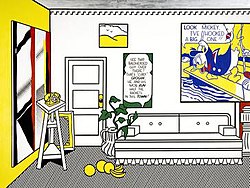Artist's Studio—Look Mickey
| Artist's Studio Look Mickey | |
|---|---|
 |
|
| Artist | Roy Lichtenstein |
| Year | 1973 |
| Medium | oil, Magna, sand on canvas |
| Movement | Pop art |
| Dimensions | 244.16 cm × 325.44 cm (96.125 in × 128.125 in) |
| Location | Walker Art Center, Minneapolis |
Artist's Studio—Look Mickey (sometimes Artist's Studio, Look Mickey, Artist's Studio – Look Mickey or Artist's Studio No. 1 (Look Mickey)) is a 1973 painting by Roy Lichtenstein. It is one of five large-scale studio interior paintings in a series. The series is either referred to as the Artist's Studio series or more colloquially as the Studios and sometimes is described as excluding the other 1973 painting, reducing the series to four.
The series refers to a set of works by Henri Matisse, with this work specifically referring to L'Atelier Rouge. The work incorporates several other Lichtenstein's works and gets its name from the large portion of Lichtenstein's Look Mickey that is included. Lichtenstein used a much more realistic representation of his own works than is standard for most artists. Elements of the work also refer to works from both Fernand Léger and Matisse.
Lichtenstein's studios reference what are known as Matisse's four Symphonic Interiors of 1911 (The Pink Studio, The Painter's Family, Interior with Eggplants, The Red Studio) and an earlier Matisse The Dance.Artist's Studio—Look Mickey was part of a series that included The Artist's Studio – with Model, 1974, Artist's Studio, Foot Medication, 1974, Artist's Studio, the "Dance", 1974, Artist's Studio/A Still Life, 1973. Artist's Studio—Look Mickey was the only one of the five to include a corner of the room, like The Red Studio. Many sources, including Lichtenstein himself only include four works in the series (excluding Artist's Studio/A Still Life, 1973). In a 1995 lecture in conjunction with the Kyoto Prize, he said "I did a series of four large, about 8' x10', paintings of interiors of artists' studios. They were inspired by Matisse's paintings..."Artist's Studio—Look Mickey is regarded as the first of the four Artist's Studio works. From among the Artist's Studio series works, this depicts "the deepest, most plainly articulated interior space."
The work, which is in part a retrospective, "conflated early modernism with emergent postmodernism". Lichtenstein refers to some of his paintings, including Look Mickey in this work, which depicts his own studio as the ideal studio and implies that the public consensus ratifies his choice of popular culture subject matter. The series depicts individual Lichtenstein works as well as groups of works in closed room that is ironically devoid of paint brushes or easels. The series served as a review of Lichtenstein's post 1961 work, with objects of his prior works decorating the room as furnishings. In Artist's Studio—Look Mickey, the couch, door, wall frieze, telephone and fruit all are drawn from earlier works and serve this setting as interior decoration, while Look Mickey is almost presented undisturbed in its entirety. Less notable works include the mirror and the Trompe-l'œil painting of the rear side of the canvas. Two other paintings were works in progress at the time of this work and one became a painting within a year after the completion of this work: the gull and the dune landscape. The speech balloon was never produced as a separate work. However, its juxtaposition to the speech balloon from Donald Duck is intriguing. He references his Entablatures works as ceiling molding.
...
Wikipedia
